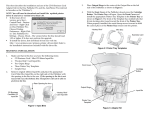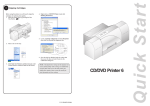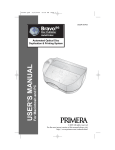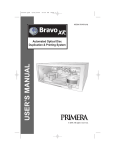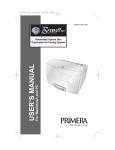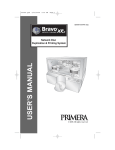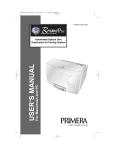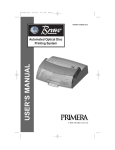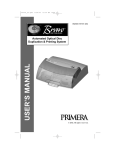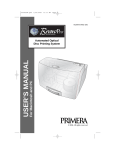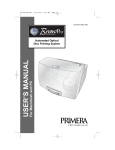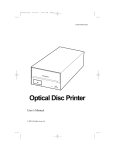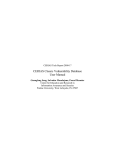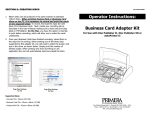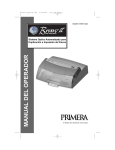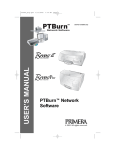Download User-Manual - Newegg.com
Transcript
510967.qxd 6/25/2007 3:33 PM Page i 062507-510967-(03) TM AUTOPRINTER For Macintosh and PC USER’S MANUAL Automated Optical Automated Optical Disc Disc Printing System Duplication & Printing System © 2007 All rights reserved 510967.qxd 6/25/2007 3:33 PM Page ii Notices: The information in this document is subject to change without notice. NO WARRANTY OF ANY KIND IS MADE WITH REGARD TO THIS MATERIAL, INCLUDING, BUT NOT LIMITED TO, THE IMPLIED WARRANTIES OF MERCHANTABILITY AND FITNESS FOR A PARTICULAR PURPOSE. No liability is assumed for errors contained herein or for incidental or consequential damages in connection with the furnishing, performance, or use of this material. This document contains proprietary information that is protected by copyright. All rights are reserved. No part of this document may be photocopied, reproduced, or translated into another language without prior written consent. Trademark Acknowledgments: Windows is a registered trademark of Microsoft Corporation. All other trademarks are the property of their respective owners. Printing History Edition 3.0, #062507, Copyright 2007, All rights reserved. FCC Compliance Statement: This device complies with part 15 of the FCC rules. Operation is subject to the following two conditions: (1) this device may not cause harmful interference, and (2) this device must accept any interference received, including interference that may cause undesired operation. For Users in the United States: This product is intended to be supplied by a UL listed Direct PlugIn Power Supply marked "Class 2"or a UL listed ITE Power Supply marked "LPS" with output rated 12VDC, 4.5A or higher. This equipment has been tested and found to comply with the limits for a Class A digital device, pursuant to Part 15 of the FCC Rules. In a domestic environment this product may cause radio interference, in which case the user may be required to take adequate measures. This equipment generates, uses, and can radiate radio frequency energy and, if not installed and used in accordance with the instructions, may cause harmful interference to radio communications. However, there is no guarantee that interference will not occur in a particular installation. If this equipment does cause harmful interference to radio or television reception, which can be determined by turning the equipment off and on, the user is encouraged to try to correct the interference by one or more of the following measures: • Re-orient or relocate the receiving antenna. • Increase the separation between the equipment and receiver. • Connect the equipment into an outlet on a circuit different from that to which the receiver is connected. • Consult the dealer or an experienced radio/TV technician for help. Use of shielded cables is required to comply with the Class A limits of Part 15 of the FCC Rules. You are cautioned that any changes or modifications not expressly approved in this manual could void your authority to operate and/or obtain warranty service for this equipment. For Users in Canada: This digital apparatus does not exceed the Class A limits for radio noise for digital apparatus set out on the Radio Interference Regulations of the Canadian Department of Communications. Le present appareil numerique n'emet pas de bruits radioelectriques depassant les limites applicables aux appareils numeriques de la class A prescrites dans le Reglement sur le brouillage radioelectrique edicte par le ministere des Communications du Canada. CAUTION! TO PREVENT FIRE OR SHOCK HAZARD, DO NOT EXPOSE THE UNIT TO RAIN OR MOISTURE. TO REDUCE THE RISK OF ELECTRIC SHOCK, DO NOT REMOVE EXTERIOR PANELS. NO USER-SERVICEABLE PARTS INSIDE. REFER SERVICING TO QUALIFIED SERVICE PERSONNEL. OPERATE THE UNIT WITH ONLY THE PROPER ELECTRICAL SPECIFICATIONS AS LABELED ON THE PRINTER AND AC ADAPTER. CAUTION! THIS PRODUCT CONTAINS A LASER DIODE OF A HIGHER CLASS THAN 1. TO ENSURE CONTINUED SAFETY, DO NOT REMOVE ANY COVERS OR ATTEMPT TO GAIN ACCESS TO THE INSIDE OF THIS PRODUCT. REFER ALL SERVICING TO QUALIFIED PERSONNEL. THE FOLLOWING LABEL APPEARS INSIDE YOUR UNIT: CLASS 1 LASER PRODUCT LASER KLASSE 1 CAUTION! USE OF CONTROLS OR ADJUSTMENTS OR PERFORMANCE OF PROCEDURES OTHER THAN THOSE SPECIFIED HEREIN MAY RESULT IN HAZARDOUS RADIATION. ii 510967.qxd 8/10/2006 8:28 AM Page iii INDEX Table of Contents Section 1: Getting Started......................................................................................1 A. Choosing a Good Location ......................................................................1 B. Unpacking and Inspection.......................................................................2 C. Identifying the Parts .................................................................................3 D. PC System Requirements.........................................................................5 E. Mac System Requirements ......................................................................5 Section 2: Hardware and Software Set-Up ........................................................6 A. Installing the PC Software .......................................................................6 B. Installing the Mac Software.....................................................................6 C. Hardware Setup ........................................................................................7 Step 1: Applying Power ...........................................................................7 Step 2: Loading Media .............................................................................7 Step 3: Connecting the USB Cable..........................................................9 Step 4: Installing the Ink Cartridge ......................................................11 Step 5: Aligning the Cartridge ..............................................................11 Section 3: Printing Discs on a PC ......................................................................12 A. Creating a Print Label Using SureThing .............................................12 B. Advanced Printer Driver Functions .....................................................14 C. Using Other Graphics Programs ..........................................................20 Section 4: Printing Discs on a Mac ....................................................................21 A. Printed Label Format Requirements ...................................................21 B. Advanced Printer Driver Functions .....................................................22 Section 5: Maintenance and Troubleshooting.................................................29 A. Interpreting the Publisher’s Indicator Lights.....................................29 B. Cleaning the Publisher ...........................................................................29 C. Performing a Robotic Self-Test ..............................................................30 D. Cleaning the Ink Cartridge....................................................................30 E. Technical Support....................................................................................31 Section 6: Technical Specifications....................................................................32 Index ........................................................................................................................33 iii Interactive.qxd 9/6/2005 3:30 PM Page 1 Interactive Feature in this PDF Document There are interactive features that will allow you to jump to different locations within the document. Each listing in the Table of Contents is interactive. Place the cursor on either the words or the page number. A small hand with a pointing finger icon appears. Click on the line with the icon and the document will jump to that page. If you want to return to the Table of Contents, move the icon to the top of the page and click on the arrow marked TOC. Navigating through the Index is similar. Place the icon on one of the listings or page numbers, click on it, and it will move to that page. The text relating to the Index listing will appear in red. Returning to the Index can be done by clicking on the arrow marked Index. 510967.qxd 7/19/2006 1:30 PM Page 1 TOC INDEX Section 1: Getting Started THANK YOU… ...for purchasing the Bravo AutoPrinter SE. Bravo is the perfect printing solution for producing professional looking CD-R and DVD-R discs. Operation is simple and completely automatic once a job has been started. To begin using your AutoPrinter, please read this manual carefully. This Operator's Manual is a complete step-by-step guide to quickly and easily printing discs with your new AutoPrinter. NOTE ON TERMS AND CONVENTIONS: From this point forward, the following terms and conventions will apply: The Bravo AutoPrinter SE will be abbreviated simply as the Publisher. Optical discs, which can include many different types of discs including CD-Rs, CD-RWs, DVD+/-Rs and more are all referred to as CDs or discs. Please note that in order to copy and record DVDs, you will need to have purchased the Disc Publisher version of the Publisher. A. CHOOSING A GOOD LOCATION • • Place the Publisher in a location with adequate air circulation to prevent internal heat build up. You will need at least 15.25" (38.73 cm) of over-head space to fully open the cover. Do not place the Publisher near heat sources such as radiators or air ducts, or in a place subject to direct sunlight, excessive dust, mechanical vibration or shock. Getting Started 1 510967.qxd 7/19/2006 1:30 PM Page 2 TOC INDEX B. UNPACKING AND INSPECTION While unpacking your Publisher, inspect the carton to ensure that no damage has occurred during shipping. Make sure that all supplied accessories are included with your unit. The following items should be included: • AutoPrinter • Power Cord and Converter • One Three-Color (CMY) Ink Cartridge • Installation Disc • USB 2.0 Interface Cable (Beige) • Warranty Card • This Operator's Manual, Quick Start Guide and Other Printed Information. Save the carton and packing materials. They will come in handy later if you ever need to transport the Publisher and/or any of its parts and accessories. 2 Getting Started 510967.qxd 7/19/2006 1:30 PM Page 3 INDEX TOC C. IDENTIFYING THE PARTS Front Panel and Top This illustration shows the Publisher and its components. Cover Power/Ink Button Ink Cartridge Carrier Recorder Tray Button Extendable Output Bin Robotic Arm Input Bin The Robotic Disc Transporter moves discs from the Input Bin, to a CD/DVD Recorder, to the printer, and finally to the Output Bin. With the cover closed, the Power/Ink Button turns the Publisher's power OFF if pressed and held for five seconds. Press it quickly to turn power back on. When already powered on quickly pressing the power button will open and close the printer tray. Getting Started 3 510967.qxd 8/10/2006 8:28 AM Page 4 INDEX TOC When the front cover is opened, the Power/Ink Button is used to position the Cartridge Carrier for easy ink cartridge replacement. The Input/Output Bins are situated under the top cover of the Publisher. The right-side bin is the Input Bin for blank media. The bin will hold up to 20 discs. The Output bin is located in front of the recorder drive. You can access the output bin by opening the front cover or by pulling the bin out. The bin can be ejected at any time while the Publisher is operating. It is recommended that you close drawer for multiple disc operation. Leave the drawer open only for single disc dispensing. The Front Cover is a durable plastic cover that will protect the Publisher from dust and interference. The Ink Cartridge Carrier holds the color ink cartridge. Rear Panel This illustration shows the input ports found on the rear panel of the Publisher: USB 2.0 Port Power Input Port The USB 2.0 Port is connected to an open USB 2.0 port on your PC with the USB 2.0 cable, included with your Publisher. The Power Input Port connects to the included power cable. The power supply is a switching 100V~240V power supply. 4 Getting Started 510967.qxd 7/19/2006 1:30 PM Page 5 TOC INDEX D. PC SYSTEM REQUIREMENTS Before getting started, it is important for you to verify that your PC meets the minimum system requirements. Here's what you need in order to successfully copy discs at 8x or above with the PTPublisher software: 700 MHz or faster Pentium III/IV processor running Windows 2000 or XP. • 512 MB or greater RAM • Free hard drive space of at least 10 GB. • Available USB 2.0 Port. (This looks the same as a USB 1.0 port. Make sure you have a USB 2.0 port for optimal performance) If your PC does not have these minimum system requirements, system performance may not be acceptable. • E. MAC SYSTEM REQUIREMENTS Before getting started, it is important for you to verify that your computer meets the recommended system requirements. Here's what you need in order to successfully burn and print with the Discribe software: • G4 PowerPC 700MHz or higher running OS X version 10.2 or higher • 256MB RAM • Free hard drive space of at least 2 GB (up to 6 GB for DVD) • Available USB 2.0 Port • Do not connect the Publisher to any USB hubs or the USB port on your keyboard. It should be connected directly to an onboard USB 2.0 port. If your computer does not have at least these minimum system requirements, system performance may not be acceptable. Getting Started 5 510967.qxd 7/19/2006 1:30 PM Page 6 TOC INDEX Section 2: Hardware and Software Setup Setup This section will describe the step-by-step process of setting up your Publisher. This includes information on how to load the supplies (ink and disc media) necessary to start producing discs. A. INSTALLING THE PC SOFTWARE The Installer Disc has a menu that will guide you through the process of setting up your duplicator. Please refer to the following for more information on each step: 1. Place the Optical Disc Publisher Installer CD in your CDRom Drive. The Installer application should automatically launch in a few moments. If it does, proceed to Step 2. If it does not automatically launch, follow these steps: Double-click the My Computer Icon, then double-click the icon of the appropriate CD drive containing the Software Installer disc. • Double-click Installer.exe In the Installer Application, click the Standard Install button. The on screen instructions will guide you step-bystep through the installation process. • 2. B. INSTALLING THE MAC SOFTWARE Please note that your user account must have administrative rights to properly install a new printer. You can check with your system administrator or check with Apple support to confirm whether or not your account has administrative rights. Install the software as follows: a. Insert the Installation CD-ROM in your system's CD-ROM drive. b. Double-click the CD-ROM icon. c. Double-click on the Disc Publisher SE Installer.mpkg file icon. Follow the on-screen instructions. 6 Hardware and Software Setup 510967.qxd 7/19/2006 1:30 PM Page 7 TOC INDEX d. The volume containing the operating system should be selected for installation. Click the Continue button. All components will be installed to their proper locations. e. Once the installation has completed, click Quit. You have successfully installed all the necessary software! Section C below will describe how to connect the Publisher to your Mac. C. HARDWARE SETUP Step 1: Applying Power Important! Remove all packing materials from the inside of the Publisher before continuing with the following steps. • Locate the power cord supplied with your Publisher. • Plug the adapter into a surge protected outlet, and plug the power plug into the power port on the rear panel of the Publisher. Step 2: Loading Media (Discs) NOTE: Your Publisher can print directly onto virtually any brand of inkjet printable-surface CD/DVD media. However, different brands of discs have different printable coatings. Because of this, you may need to adjust the printer driver settings to accommodate your specific brand of CD/DVD media. Refer to Section 3-D and 4-D for further printer driver information. Due to the wide variety of printable-surface CD/DVD media, you may find that certain brands of discs provide higher print quality than others. For maximum print quality, use CD/DVD media authorized by Primera. Hardware and Software Setup 7 510967.qxd 7/19/2006 1:30 PM Page 8 TOC INDEX Refer to the following steps when loading discs in to the Publisher: • Open the front cover of the Publisher • The Publisher will automatically position the cartridge carrier and Robotic Disc Transporter to allow for easy access to the bin. • Load the Input Bin (the bin located on the right-hand side of the Publisher) with 20 blank discs. 8 Hardware and Software Setup 510967.qxd 7/19/2006 1:30 PM Page 9 INDEX TOC Step 3: Connecting the USB 2.0 Cable Connect the Publisher to your PC or Mac with your beige USB 2.0 Cable. If you are using a PC, after a few moments, Windows will tell you it has found new hardware and is looking for software to install it. Select "Install the software automatically" and click Next. You may see a notice like the one shown here stating that the Printer has not passed Windows Logo Testing. Click Continue Anyway to continue installing the printer driver for your Publisher. Hardware and Software Setup 9 510967.qxd 8/10/2006 8:28 AM Page 10 TOC INDEX When connecting USB to a Mac it may be necessary to Add the printer via the Printer Setup Utility. 1. Open the Printer Setup Utility located in the Applications Utilities folder. 2. Click Add. Select the Disc Publisher XRP from the list of available printers. Click Add again. 10 Hardware and Software Setup 510967.qxd 8/10/2006 8:28 AM Page 11 INDEX TOC Step 4: Installing the Ink Cartridge With the cover open, press the Power/Ink Button to move the Ink Cartridge Carrier to the load position. • Open the cartridge cover by pressing down on the tab. • Remove the ink cartridge from its packaging. • Slowly remove the tape covering the cartridge's print head. DO NOT TOUCH THE COPPER AREA! • Insert the ink cartridge into the carrier, copper end first and snap the cartridge cover in place. • Close the Publisher's front cover. • Step 5: Aligning the Cartridge If you are using a PC the Installer will prompt you to align the cartridge. If you are using a Mac you will be prompted to align the cartridge before you print for the first time. Note: An alignment print is required every time you install a new cartridge. The software will always prompt you to align the cartridges. Make sure there is an unprinted disc in the bin for this alignment. Hardware and Software Setup 11 510967.qxd 7/19/2006 1:30 PM Page 12 TOC INDEX Section 3: Printing Discs on a PC SureThing CD Labeler is used to design the printing on your discs. This application will be described in detail in this section. A. CREATING A PRINT LABEL USING SURETHING The SureThing Disc Labeler software included with your Publisher is a great tool for creating professional looking discs. You can use SureThing's Smart Designs to quickly label a disc, or easily import your own design in many popular file formats. The Help section included with the software will provide complete instructions on all the features in this package. (Go to the Help Menu - Choose Contents) The following is a tutorial on creating a basic disc design: 1. Open the SureThing program. Choose the 120mm DiscTemplate from the window that appears. 2. Open the background panel by click the arrow on the background button. Add your own background to the label by choosing Select Backgound. 3A. Browse to the location of your background image. To avoid skewed or blurry printing make sure your image is 120mm square and of sufficient resolution. We recommend 300 dpi. 12 Printing Discs on a PC 510967.qxd 7/19/2006 1:30 PM Page 13 TOC INDEX 3B. Instead of your own background, you can also choose from several included Surething backgrounds. To choose one of these images click the SureThing Background button in the Browse window that appears when you click Select Background. Also, you can easily toggle through the backgrounds by using the toggle bar below the label. Backgrounds are controlled by the far left toggle button. 4A. Open the text panel by clicking the arrow on the text button. Add text by selecting one of the options below. To create text that follows the curve of the disc choose Add Circular Text. 4B. You may also choose from several SureThing smart designs. These design templates automatically position your text and use certain text effects to give your label a professional look. You can easily toggle through smart designs by using the middle toggle button on the toggle bar below the label. 5. Finally, Open the picture panel by clicking the arrow on the Pictures/Clipart button. Add any logos, graphics or symbols to the label. These graphics will appear on top of the background image. You can size them appropriately by dragging the corner of the selected graphic. 6. When you have completed design work save your label by choosing Save Project in the Actions panel. 7. TO PRINT simply go to the file menu and choose Print. Select the Disc Publisher SE as the printer. Set the number of copies. Click OK. (If you would like to edit print options for this job only, click the OPTIONS button before you click OK. Options are described in the next section.) Printing Discs on a PC 13 510967.qxd 7/19/2006 1:30 PM Page 14 TOC INDEX B. ADVANCED PRINTER DRIVER FUNCTIONS Once the Publisher software has been successfully installed, you will want to take a moment to familiarize yourself with the printer driver settings for your Publisher. These settings affect the print quality of your discs. The default settings of the Publisher printer driver will fit most printing needs. Please refer to the following steps to change or verify your default printer driver options. Changing these settings will affect the print quality of a disc printed from any application including SureThing. 1. Click the Start button. For Windows 2000 point to Settings and click on Printers. For XP Professional click on Printers and Faxes. For XP Home click on Control Panel, then click on Printers and Other Hardware, then click on Printers and Faxes. Click on the Disc Publisher SE icon with the right mouse button and select Printing Preferences. 14 Printing Discs on a PC 510967.qxd 7/19/2006 1:30 PM Page 15 TOC INDEX NOTE: These settings are also accessible via the options button in the print window of SureThing. However, changing these settings via SureThing will only affect that particular print image. To change default settings use the method described above. Paper Size The paper size option will be set to CD for printing onto printable surface CDs and DVDs. The remaining options apply if you have purchased the business card adapter kit. Non-printable Outer Margin Adjust this value to print all the way to the outer edge of a CD. This is useful if you are printing full coverage images. The lower you set this value the farther to the outer edge of the CD you will print. Please note that with most media the printable surface does not extend all the way to the edge of the disc. Print Quality This setting affects the quality, speed and ink usage of the print. Color matching is also tied to this setting. Start with the default setting for fastest printing and the least amount of ink consumption. If the quality needs improvement move to the next highest setting. Printing Discs on a PC 15 510967.qxd 7/19/2006 1:30 PM TOC Page 16 INDEX Disc Surface Quality This setting affects the quality, speed and ink usage of the print. Color matching is also tied to this setting. Start with the default setting for fastest printing and the least amount of ink consumption. If the quality needs improvement move to the next highest setting. Color Matching Best for Graphics mode is best used for graphical images where accurate color reproduction is not as essential. Images printed in this mode will look more vibrant because more ink is being used to produce them. However, printing images of people may produce skin tones that have a reddish tint. Best for Photos mode is best used for photographic images where accurate color reproduction is very essential. Images printed in this mode will look lighter than those printed in Photo mode. Skin tones especially will look more natural in this mode. NOTE: Exact color matching of the printed discs to the screen may never be possible since there are factors that affect this out of the drivers control. The surface of the disc reacts with the ink in the cartridge to produce the color. For this reason, when printing the same image to different types of discs with different surfaces the printed output can look entirely different. Ink Saturation This option controls the ink saturation of the printed image. When printing onto the printer manufacturer's TuffCoat CD media, this option can be left at its default setting of 100%. When printing onto other brands of printable CD media, you may need to adjust this control in order to optimize the ink saturation for the printable surface of your specific CD media. If discs do not seem to be drying completely it may be necessary to reduce this value. Calibration Options Click on the plus to reveal the following four Calibration options. 16 Printing Discs on a PC 510967.qxd 7/19/2006 1:30 PM Page 17 INDEX TOC Inner Diameter This value changes the size of the non-printed center. Larger numbers cause the non-printed center to be larger and smaller numbers make the non-printed center smaller. This number is incremented by 0.1mm so a change of 10 for inner diameter changes the diameter by 1mm. Inner Diameter Non-Printed Diameter 230 0.905" (22.0mm) (TuffCoatTM, Default) 150 0.591" (15mm) (Physical Center) Cartridge Alignment The Cartridge Alignment prints a test print and then automatically scans the print to configure your printer for bidirectional printing and to align the color cartridge. It is important to perform this calibration every time you change a cartridge. If you forget to perform this calibration you will be prompted to do so before your first print from the new cartridge. Center The Print Image NOTE: Your printer comes from the factory pre-calibrated to print the image in the center of the CD. You can use this adjustment if you need to fine-tune this location. If you ever wish to verify your factory-calibrated Vertical and Horizontal calibration settings, you can run a simple calibration procedure to assure that your images will be centered when printed on a CD. To do this, refer to the following steps: 1. Verify that a disc and a color ink cartridge are installed in the Publisher. It is important to use the same disc you normally use for your publishing because different brands of discs may vary slightly in size. Also, verify that the Publisher is powered ON and that it is connected to your computer. 2. Click on the Center the Print Image and then the Properties button. The printer will begin printing the calibration test print. Printing Discs on a PC 17 510967.qxd 7/19/2006 1:30 PM Page 18 INDEX TOC 3. When the print is complete, rotate disc 180º and put the disc back in the input bin and repeat step 2 using the same disc. 4. When the second run of the print is complete, you should have a test print that looks similar to the following: BACK Vertical Calibration After printing this image once, rotate this CD so the ARROWS point to the BACK of the printer and print again. 5 4 3 2 1 0 -1 -2 -3 -4 -5 Find and enter the number whose lines tough (must be the SAME number) NOTE: -5 -4 -3 -2 -1 0 1 2 3 4 5 BACK -5 -4 -3 -2 -1 0 1 2 3 4 5 5 4 3 2 1 0 -1 -2 -3 4 -5 Find and enter the number whose lines tough (must be the SAME number) Horizontal Calibration 5. Along the Vertical axis of the printed disc, find the number whose lines touch. For example, in the above illustration, Enter the number 2 into the Vertical box of the Calibration window and 0 for the Horizontal axis. 6. Select the OK button. Your images should now be centered when printed on a disc. After your selections have been made, close out of the printer setup window. You are now ready to go to an application program and print. All printer driver selections will stay the same until you change them. 18 Printing Discs on a PC 510967.qxd 7/19/2006 1:30 PM TOC Page 19 INDEX Clean/Change Cartridge & Check Ink Levels Select this button to display the current ink levels as well as options for cleaning and changing cartridge. Change Cartridge Select the Change Cartridge button to install a new ink cartridge or to switch back and forth between previously used cartridges. Clean/Purge Select Clean/Purge button to send a simple test pattern to the printer. Be sure to have a disc in the Publisher's input bin and the front cover closed. The test pattern purges ink through nozzles of your ink cartridge to clear any blockages. Details Select the Details button for information on the drivers, firmware, alignment and number of discs printed with your Publisher. Click Reset Factory Default to set all print centering and cartridge alignment settings back to factory defaults. Printing Discs on a PC 19 510967.qxd 7/19/2006 1:30 PM Page 20 TOC INDEX Enable Bi-di Printing Set this option to Yes for faster printing that requires cartridge alignment. Set it to no for slower printing that does not require cartridge alignment. C. USING OTHER GRAPHICS PROGRAMS While SureThing will handle most labeling needs, other graphics programs can be used if you prefer. TO PRINT FROM ANY PROGRAM simply go to the file menu of that program, set the number of copies and click OK or Print. The Publisher will take care of the rest. When creating images in other graphics programs we recommend creating a 4.72 x 4.72 square image that has a 300 dpi resolution. The image does not need to be round because the Publisher driver automatically crops the outer and inner circle according you the settings you specify in the driver preferences. 20 Printing Discs on a PC 510967.qxd 7/19/2006 1:30 PM Page 21 INDEX TOC Section 4: Printing Discs on a Mac A. PRINTED LABEL FORMAT REQUIREMENTS The Publisher does not include a graphics printing program for the Macintosh. However, just like any printer you may print to the Publisher from any program on your Macintosh. Typical graphics programs that can be used with the Publisher include the following: Adobe Illustrator, Adobe Photoshop, Magic Mouse Discus and Macintosh Preview. Illustrator, Photoshop and Discus can be used to create an image. Macitosh Preview can be used to print any print label in a standard format such as JPG, TIF or BMP. The driver will center the image and automatically crop it to the shape of a CD. Simply create a custom page size of 120mm (4.72 inches) square and center your image in that area and the driver will do the rest. The center sizes listed in Section D should guide you in creating your disc. Because the driver crops the image to the shape of a CD, you do not want to make your design round. You will find it is best to "over bleed" your design by filling the whole 120mm area with your image. This ensures the outer and inner diameters will print perfectly round on your disc. Label Format Requirements: • 4.72 x 4.72 (120mm) Square Image. • No Circular Images. • 300 DPI is recommended. In order to help you design your label, included on the installation disc are templates in eps format. These templates will help you get started designing your label. Remember, you do not need to use these templates. You can simply use the label format requirements above. To use the template follow these steps: 1. Open the template in Photoshop or Illustrator. 2. Create a new layer for your image or graphics. (Make sure the template layer is on top of the image layer) 3. Place your image or design your graphics on the new layer. Use the template as a guide for image and graphics placement. Printing Discs on a Mac 21 510967.qxd 7/19/2006 1:30 PM Page 22 TOC 4. INDEX Before you print or save your image in another format, either hide the template layer or delete the template layer. The circular shape and center cut out should not be printed. Use it only as a guide to layout your image. B. ADVANCED PRINTER DRIVER FUNCTIONS The following section will examine the printer driver settings that affect the print quality of your discs. While the default settings will fit most printing needs, it is a good idea to familiarize yourself with these settings to optimize your print quality. The printer driver settings are contained in two areas, Page Setup and Print Setup. You can access the driver settings as follows: 1. From any printing application, click the Page Setup and set Format For to Disc Publisher SE. 2. The paper sizes for the Publisher refer to the type of disc to which you will be printing. The available sizes are: CD/DVD, Business Card Disc, 80mm CD and Hockey Rink Disc. 22 Printing Discs on a Mac 510967.qxd 7/19/2006 1:30 PM TOC Page 23 INDEX Print Settings To access printer settings, click Print from any application. The print window will be displayed. Click the Copies and Pages button and select Publisher Settings option in the dropdown menu to see the full pane and access all the printer driver settings. The following is a description of the printer driver settings: • • • Print Quality There are three options for image quality. Keep in mind that Normal provides the fastest print at lower quality while Best delivers the best quality at a slower print speed. Disc Surface Quality This setting also affects the Quality of the printed image by altering the color matching profile. Start with the default setting for fastest printing and the least ink consumption. If the quality needs improvement, move to the next highest setting. Color Matching Graphic mode is best used for graphical images where accurate color reproduction is not as essential. Images printed in this mode will look more vibrant because more ink is being used to produce them. However, printing images of people may produce skin tones that have a reddish tint. Printing Discs on a Mac 23 510967.qxd 7/19/2006 1:30 PM Page 24 TOC INDEX Photo mode is best used for photographic images where accurate color reproduction is very essential. Images printed in this mode will look lighter than those printed in Photo mode. Skin tones especially will look more natural in this mode. NOTE: Exact color matching of the printed discs to the screen may never be possible since there are factors that affect this out of the drivers control. The surface of the disc reacts with the ink in the cartridge to produce the color. For this reason, when printing the same image to different brands of discs with different printable surfaces the printed output can look entirely different . • • • • Intensity The Intensity setting will control the amount of ink saturation on the disc. When printing onto the Primera ToughCoat discs, 96% is usually sufficient. When printing on to other brands of media, or if you would like to print darker colors, you may wish to increase the Intensity setting. Inner Diameter The inner diameter refers to the size of the non-printed center on your disc. The size of the center hub can vary from one type of media to the next. This allows you to set the inner diameter in millimeters allowing you to print all the way to the center hub regardless of the type of disc you are using. For the discs that Primera sells, use the following guide for Inner Diameter: − 23 mm for Primera's Tuff-Coat CDR − 24.9 mm for the Hockey Rink Disc, Business Card Disc and 80mm CD Outer Margin The Outer Margin refers to where the printing will cut off around the outer edge of your disc. The size of the printable surface can vary from one type of media to the next. This allows you to set the outer margin in millimeters allowing you to print all the way to the edge regardless of the type of disc you are using. Save As Default The Save As Default button will save the current settings as the system-wide defaults. 24 Printing Discs on a Mac 510967.qxd 7/19/2006 1:30 PM Page 25 TOC • • INDEX Restore Defaults The Restore Defaults button will restore the driver settings to the factory defaults. Config Utility This button launches the Configuration Utility. The Configuration Utility is a program that installs with your Publisher software. This utility allows you to monitor ink levels, maintain and calibrate the ink cartridge and align printing on the disc. The Configuration Utility can be launched from the Print Center in OSX by doing the following: 1. Click the Finder 2. Click the Applications Icon 3. Scroll to Print Center (Printer Setup Utility in OS X v. 10.3 or greater) 4. Highlight the Disc Publisher SE and click the Configure (Utility in OS X v. 10.3) Icon You can also launch the Configuration Utility from the Disc Publisher SE printer settings in any printing application by clicking File then Print and selecting Publisher Settings. In Publisher Settings you will find a button to launch the Configuration Utility. When launched, the following window appears: Printing Discs on a Mac 25 510967.qxd 7/19/2006 1:30 PM Page 26 TOC INDEX You will see the Color Ink Level is displayed. The Color Ink Level represents the lowest color in your cartridge. For instance, if your cartridge has 80% cyan 50% yellow and 65% magenta ink remaining, the level reported would be 50%. You will also see the following buttons: Clean Cartridge A cartridge that sits idle in the Publisher for a period of time may start to experience some drying of ink in the tiny nozzles that make up the print head. Clicking the Clean Cartridge button will cause the Publisher to pick a disc and place in into the printer tray. The Publisher will then print a simple pattern that will flush ink through the nozzles. The test pattern will also show you if any nozzles are clogged. In the pattern you will see some diagonal lines which should be continuous; breaks in those lines indicate a clogged nozzle. Please note that it may require more than one cleaning to fully clear all nozzles. If the nozzles are not fully clear after a few cleaning prints, it may be necessary to remove the cartridge and actually clean the print head by gently blotting the nozzles with a moist cloth or paper towel and replace it in the Publisher. See Section 5-B. Change Cartridge If you need to change the cartridge, it is a good idea to use the Change Cartridge button in the Configuration Utility. This ensures the most accurate tracking of ink levels. To change a cartridge, click the Change Cartridge button. The cartridge holder will move to the center of the Publisher to make it easier to install the cartridge. Lift the top cover and install the cartridge as described in Section 2 of this manual. You will be prompted to let the system know whether or not you are installing a new or used color cartridge. Once installed, click the OK button and the system will update your cartridge levels. Alignment Calibration Print The Cartridge Alignment prints a test print and then automatically scans the print to configure your printer for bidirectional printing. It is important to perform this calibration every time you change a cartridge. If you forget to perform this calibration you will be prompted to do so before your first print from the new cartridge. 26 Printing Discs on a Mac 510967.qxd 7/19/2006 1:31 PM Page 27 INDEX TOC Image Alignment The Image Alignment button will allow you to nudge the image up, down, left, or right on your disc. To center the image, click the Image Alignment button. You will be prompted with a choice to print a test print or simply enter values to nudge the image alignment on the disc. If you do not know the direction and distance to move the image in order to center it on your disc, you can opt to print the centering test print. Make sure the Publisher has discs and an ink cartridge installed, and it is connected and ready to receive a print job, and then click the Yes button. The Publisher will pick a disc and print a scale of numbers on it. You will be prompted to open the Publisher's front cover, rotate the printed disc 180 degrees, reload it into the input, and close the cover. Click OK when ready and the Publisher will pick the disc and print another scale of numbers. The disc should look like this: BACK Vertical Calibration -5 -4 -3 -2 -1 0 1 2 3 4 5 5 4 3 2 1 0 -1 -2 -3 4 -5 Find and enter the number whose lines tough (must be the SAME number) Horizontal Calibration After printing this image once, rotate this CD so the ARROWS point to the BACK of the printer and print again. 5 4 3 2 1 0 -1 -2 -3 -4 -5 Find and enter the number whose lines tough (must be the SAME number) NOTE: -5 -4 -3 -2 -1 0 1 2 3 4 5 BACK Printing Discs on a Mac 27 510967.qxd 7/19/2006 1:31 PM Page 28 TOC INDEX Once the print has finished, you will see the following dialog box: Look at the finished alignment disc and pick the numbers that come closest to lining up with one another. For instance, on the disc shown in this manual, the vertical alignment is 2 and the horizontal alignment is 0. Enter this in the alignment dialog box. If you choose not to print the test print, you will simply see the alignment dialog box and can enter values to move the image. The unit of measure is roughly 0.1mm. Making the Horizontal Calibration number smaller or more negative will move the image slightly to the left. Making the Horizontal Calibration a larger value, or more positive will move the image to the right. If the Vertical Calibration number is made smaller, or more negative the image will move slightly up. If the Vertical Calibration is set to a larger value, or more positive value, the image will move down on the disc. Calibrate Last Disc Use this calibration if you frequently receive false messages that two discs were picked. When you press this button you will be prompted to place one disc in the input bin. The Publisher will then touch each disc with the robotic arm to set the correct measurement for the last disc in the bin. 28 Printing Discs on a Mac 510967.qxd 7/19/2006 1:31 PM Page 29 INDEX TOC Section 5: Maintenace and Troubleshooting A. INTERPRETING THE PUBLISHER’S INDICATOR LIGHTS The Power/Ink button can tell you what is happening inside the Publisher. Please refer to the following: Power/Ink Button Publisher Fast Flashing The Publisher is initializing.You will see this pattern when the Publisher is first turned on. Wait until the lights stop blinking before opening software or starting jobs. Slow Flashing The cover is open and the ink cartridge carrier is in change position. Insert a new cartridge and close the cover. (The slow flashing light can also indicate an out of media condition, a robotic error or a picking problem. However, these conditions are always paired with a error message on screen.) B. CLEANING THE PUBLISHER NOTE: Do NOT attempt to oil or grease the Publisher's Robotic Arm shaft or other components. You will likely cause more harm than good! Any moving parts are designed to operate for the life of the machine with no additional lubrication required. Use a clean, lint-free rag with a small amount of ammonia window cleaner to clean the Publisher's outside case and trays. This type of cleaner is very effective on inks that may accumulate on the printer tray. Stronger cleaning solutions are NOT recommended because they may damage the paint and plastic materials from which the parts are manufactured. Always disconnect your Publisher's power cords before cleaning. Resume operation only after the surfaces are completely dry. Maintenance and Troubleshooting 29 510967.qxd 8/10/2006 8:29 AM Page 30 TOC INDEX C. PERFORMING A ROBOTIC SELF-TEST To ensure that everything is working properly, a Self-Test feature is built in to your Publisher. In this mode, the Robotic Disc Transporter will go through the motions of picking and placing a disc to ensure proper working order. This test may be performed without connecting the Publisher to the PC. Perform the test by doing the following steps: • • • • Load some discs into the Input Bin. Open the cover. Press and hold the power button for five seconds. The test will start. To stop the test, close the cover and press the power button. D. CLEANING THE INK CARTRIDGE It may be necessary to clean the ink cartridge nozzles if you notice reduced print quality, or if you suspect an cartridge nozzle has become slightly dried out or clogged. If you are having print quality problems, follow the steps below: 1. Remove the print cartridge. 2. Moisten a lint-free cloth with water. 3. Hold the cloth against the nozzles for three seconds. This will “wick” some additional ink onto the damp cloth. 4. Wipe in the one direction only. 5. Repeat the process. 30 Maintenance and Troubleshooting 510967.qxd 6/25/2007 3:34 PM Page 31 INDEX TOC E. TECHNICAL SUPPORT If you have difficulties in operating your Publisher, the procedures in this manual and the software User's Guide should, in most cases, solve the problem. If you still have difficulty, contact the technical support number listed on the insert included in the supply pack that came with your Publisher. Source Location Primera Knowledge Base www.primera.com/knowledgebase.html SureThing Software Help files Open the software. Click on the Help Menu - Contents Email Support www.primera.com/contact_tech_support.cfm Chat Support www.primera.com/knowledgebase.html Phone Support 763-475-6669 (Mon - Fri 8 a.m. - 7 p.m CST) Maintenance and Troubleshooting 31 510967.qxd 7/19/2006 1:31 PM Page 32 INDEX TOC Section 6: Technical Specifications Model AutoPrinter SE Printing Method Ink-Jet Printing Resolution 4800 x 1200 dpi, 2400 x 1200 dpi, 1200 x 1200 dpi, 600 x 600 dpi Ink Types One 3-color (CMY) cartridge Media Types Ink-Jet Printable Surface CD-R, CD-RW, DVD-R, DVD RAM, DVD+R, Dual Layer DVD+R. Maximum print width 4.724" (120mm) Minimum PC System IntelTM Processor III/IV 750 MHz or higher, 256MB RAM minimum, 512 MB recommended, available PCI slot, one free USB 2.0 port Minimum MAC System G4 PowerPC 700MHz or higher running Mac OS Version 10.2 or higher, 256MB RAM minimum, 2GB free hard disk space (6GB for DVD) Disc Capacity 20 disc input, 20 disc output Operating Systems Windows XP and Windows 2000 Mac OSX Version 10.2 or higher Interface USB 2.0 port Power Requirement 100-120VAC / 220-240VAC Weight 10.4 lbs (4.71 kg) Dimensions 6.75'' H x 15" W x 15" D (14.15 cm x 38.1 cm x 38.1 cm) EMC Certifications FCC Class A, CE Safety UL, UL-C, CE, RoHS Warranty One year return-to-depot 32 Technical Specifications 510967.qxd 7/19/2006 1:31 PM Page 33 TOC Index Alignment Calibration..................................................................26 Cartridge, Change ....................................................................19, 26 Centering Test Print.......................................................................27 Color Matching.........................................................................16, 23 Connections, Rear Panel .................................................................4 Identifying the Parts........................................................................3 Ink Levels and Cartridge Maintenance.....................................19 Ink Saturation.................................................................................16 Input Bin............................................................................................4 Inner Diameter .........................................................................17, 24 Output Bin.........................................................................................4 Paper Size ........................................................................................15 Power/Ink Button.........................................................................3, 4 Power Input.......................................................................................4 Resolution........................................................................................32 Specifications..................................................................................32 System Requirements .....................................................................5 Technical Support ..........................................................................31 Index 33 510967.qxd 7/19/2006 1:31 PM Page 36 Printed in the United States of America P/N 510967







































